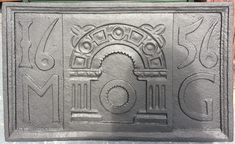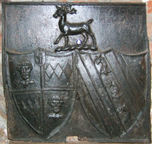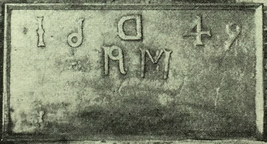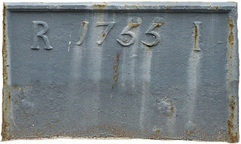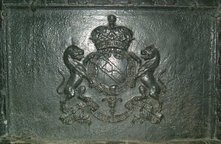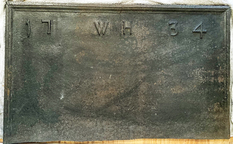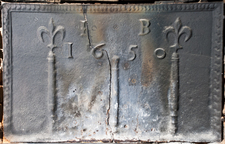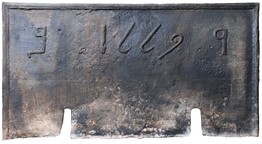-
1099
Description: Rectangular shape; ovolo-moulded edging; raised central rectangular panel with inset stylised design of a rounded arch upon Ionic columns, the inside edge indented; at quarter angles outside the arch, two trefoils; within the arch, sequence of linked hollow strapwork rhomboids and circles; between the columns, a roundel with the internal edge indented; left of the central panel, 16 above upper-case M in low relief; right of the central panel, 56 above upper-case G in low relief.
Notes: An unusually small but well-preserved back with a stylised design. The style of the numerals, particularly the 6 and 5, can be seen on a larger fireback of 1653.
Copies of this fireback are known.
Inscription: 16 56 / M G
- Decoration tags:
- rectangular (shape)
- ovolo (edging)
- carved stamps
- whole carved pattern
- individual letters
- individual numbers
- architectural
- text
Manufactured: in 1656 in the Weald area of England.
Current location: Avery Way, Tamar View Industrial Estate, Saltash, Cornwall, England.
- Attached to series:
- Date & initials firebacks
- 1650s Wealden series
-
1031
Description: Rectangular; astragal and fillet edging; two heater-shaped shields side by side, with a stag trippant crest above centre.
Notes: The dexter shield: quarterly first and fourth - Mostyn baronet - Gules a saracen's head erased proper wreathed about the temples sable and argent; second and third, within a bordure a fess fusily (or three lozenges in fess); a baronet's inescutcheon in the centre chief. The sinister shield - Sale - Argent on a bend cotised three gryphons' heads erased. Crest (Mostyn), a stag trippant proper.
Arms: Left: Mostyn with unknown quartering; right: Sal, Sale, Salle or Salley
- Decoration tags:
- rectangular (shape)
- astragal & fillet (edging)
- carved stamps
- heraldic
- armorial
- animals
- humans
Manufactured: in the 19th century in England.
Current location: in private hands, Saxtead, Suffolk, England.
- Attached to series:
- Personal armorial firebacks
-
1098
Description: Rectangular shape; indeterminate moulded edging; central initials (A? D M)in triad, between split date (6 reversed).
Notes: The characters have been derived from an odd assortment: the numbers appear to be a recognisable character set, with the 6 and 9 interchangeable, although 6 has been inadvertently reversed; the 6/9 has also been used, with the same stamp as has been used to form the uprights of the M, to construct a probable capital A (or R); the nature of the stamps forming the M is unclear. Noted in 1939 at Palfrey Farm, near Petworth, West Sussex, which from the mid-16th century had been home to the Penycod family, suggesting that the fireback had not been original to the house.
Inscription: 16 / A[?] D M [triad] / 49
- Decoration tags:
- rectangular (shape)
- indeterminate moulded (edging)
- simple stamps
- carved stamps
- text
Manufactured: in 1649 possibly at Frith Furnace, Northchapel in the Weald area of England.
Current location: not known.
Citation: Smail, H. C. P., Apr 1939, 'Iron Firebacks' [letter], Sussex County Magazine, 13, 4, p. 284.
- Attached to series:
- Date & initials firebacks
- Petworth lettering series
-
1287
Description: Rectangular shape; ovolo-moulded edging; top centre, date between split initials.
Notes: The letters and numerals are particularly well formed. The fireback is displayed out of doors against a wall at the side of the street and the lower part is recessed into the pavement.
Inscription: R 1755 I
- Decoration tags:
- rectangular (shape)
- ovolo (edging)
- carved stamps
- individual letters
- individual numbers
- text
Manufactured: in 1755 possibly in the Weald area of England.
Current location: 15-17 High Street, Seaford, East Sussex, England.
- Attached to series:
- Date & initials firebacks
-
683
Description: Rectangular; twisted rope edging (top and sides); top left and right, Tudor rose surmounted by a crown (separate stamps); right of centre, irregular pentagram formed of a repeated length of twisted rope enclosing a Tudor rose; on either side of top point of pentagram, a triple-loop stamp irregularly spaced.
Notes: The pentagram has both Christian and occult symbolism. The fleur and the rose and crown have been seen on another fireback.
Copies of this fireback are known.
- Decoration tags:
- rectangular (shape)
- rope (edging)
- simple stamps
- carved stamps
- heraldic
- apotropaic
- objects
Manufactured: in the late-16th century possibly in the Weald area of England.
Current location: in private hands, Sevenoaks, Kent, England.
- Attached to series:
- Rope design firebacks
- Looped fleur series
-
688
Description: Rectangular; astragal edging; in centre, shield, supporters, ducal coronet, motto and garter of the Duke of Dorset: Quarterly, Or and gules, a bend vair.
Notes: Almost certainly the arms of Lionel Sackville KG (1688-1765), created first duke of Dorset in 1720.
Inscription: [around shield] HONY SOIT QUI MAL Y PENSE / [on motto scroll] AUT NUNQUAM TENTES, AUT PERFICE
Arms: Lionel Sackville, 1st Duke of Dorset
- Decoration tags:
- rectangular (shape)
- astragal (edging)
- carved pattern panels
- armorial
- text
Manufactured: in the early-18th century in the Weald area of England.
Current location: Knole, Sevenoaks, Kent, England.
(part of the National Trust museum group)
- Attached to series:
- Dorset arms series
- Sackville firebacks
- Personal armorial firebacks
-
1236
Description: Rectangular; ogee moulding on top and side edges; symmetrical layout of date and initials; date split between left and right sides, initials in middle.
Notes: One of a series of backs dating to the 1730s and 40s using very similar sets of letters and numerals. Formerly at Yeomans, Mayfield, Sussex.
Inscription: 17 / WH / 34
- Decoration tags:
- rectangular (shape)
- cyma reversa/ogee (edging)
- carved stamps
- individual letters
- individual numbers
- text
Manufactured: in 1734 in the Weald area of England.
Current location: not known.
- Attached to series:
- 1730s-40s, date & initial series
- Date & initials firebacks
-
1285
Description: Rectangular; ovolo-moulded, gadrooned edging (top and sides); lower centre, a vertical spindle between two vertical spindles of a different form each surmounted by a fleur-de-lys; the date split by the top of the middle spindle; the initials above the first two and last two figures of the date.
Notes: The gadrooned style of edging is a distinctive feature of this group of firebacks, the style of fleur-de-lys being observed on two other backs within the group.
Inscription: I B / 1 6 5 0
- Decoration tags:
- rectangular (shape)
- gadrooned (edging)
- simple stamps
- carved stamps
- individual letters
- individual numbers
- heraldic
- text
- objects
Manufactured: in 1650 possibly at Cuckfield Furnace in the Weald area of England.
Current location: in private hands, Waltham St Lawrence, Berkshire, England.
- Attached to series:
- Spindle series
- Spindle/distaff firebacks
- Date & initials firebacks
-
1094
Description: Rectangular; twisted rope edging (top and sides); top centre, crowned Tudor royal shield between a lion passant on the right and a lion passant guardant sinister on the left; in each top corner a crowned four-petal rose, below which, to the right, a left-facing 'imp' with both arms lowered; below the armorial, a crowned shield bearing initials, KH, in Lombardic lettering, above a fleur-de-lys; a much-corroded imp figure may be below the right-hand lion.
Notes: A heavily corroded variant of a type bearing Henrician heraldic elements.
Arms: Tudor royal arms of England
- Decoration tags:
- rectangular (shape)
- rope (edging)
- carved stamps
- heraldic
- armorial
- animals
- humans
Manufactured: in the mid-16th century in the Weald area of England.
Current location: Smallhythe Place, Small Hythe Road, Tenterden, Kent, England.
Museum number: 1117950 (part of the National Trust museum group)
- Attached to series:
- Royal series
-
903
Description: Rectangular; ovolo-moulded edging (top and sides); date between split initials across upper half of plate; two notches cut away for insertion of firedogs.
Notes: The ‘6s’ appear to have been moulded from a type of jemmy.
Inscription: g 1669 P [reversed]
- Decoration tags:
- rectangular (shape)
- ovolo (edging)
- simple stamps
- carved stamps
- individual letters
- individual numbers
- text
- objects
Manufactured: in 1669 possibly in the Weald area of England.
Current location: George & Dragon Inn, Speldhurst Hill, Speldhurst, Kent, England.
